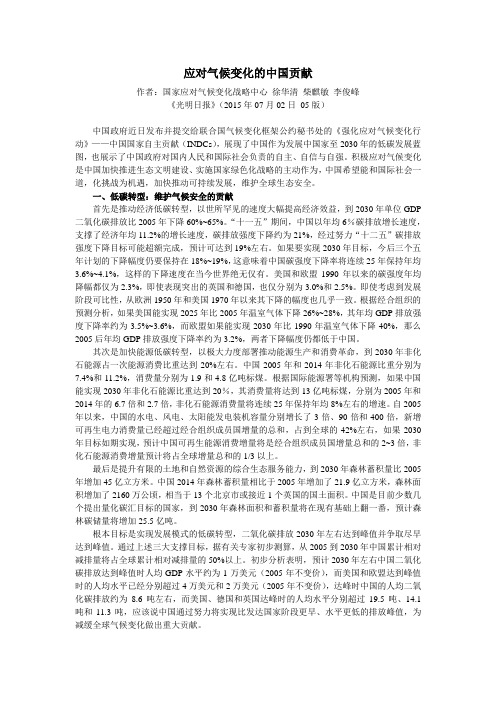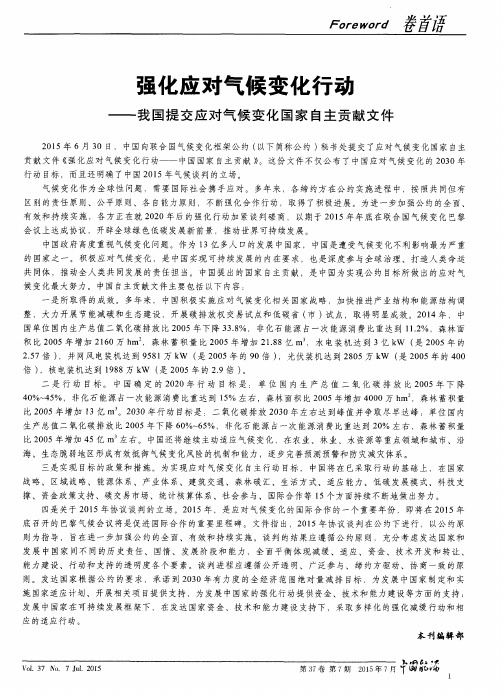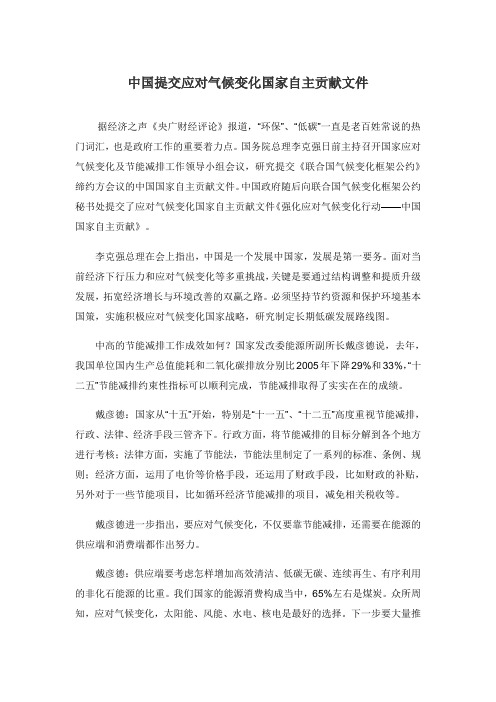强化应对气候变化行动——中国国家自主贡献(中英对照)
- 格式:doc
- 大小:38.26 KB
- 文档页数:18

驻英国大使傅莹有关“气候变化与中国”的演讲中英对照很好的口译材料Resilience, from China and the World's Perspective ——Address by Chinese Ambassador, Fu Ying, at the "China and Climate Change Summit"气候变化峰会开幕辞——中国驻英国大使傅莹的演讲Ladies and gentlemen,女士们、先生们,I am delighted to be here today at the "China and Climate Change Summit".很高兴今天能在“中国与气候变化峰会”上与诸位相聚。
Climate change is one of the greatest challenges facing humanity in the 21st century. It knows no borders and affects people from all corners of the globe. To tackle this issue, we need concerted efforts and joint actions from all countries. As one of the major economies and the largest developing country in the world, China is fully committed to addressing climate change and has made significant achievements in this field.气候变化是21世纪人类面临的最大挑战之一。
没有国界,影响全球各个角落的人们。
为了解决这一问题,我们需要各国的共同努力和行动。

应对气候变化的中国贡献作者:国家应对气候变化战略中心徐华清柴麒敏李俊峰《光明日报》(2015年07月02日05版)中国政府近日发布并提交给联合国气候变化框架公约秘书处的《强化应对气候变化行动》——中国国家自主贡献(INDCs),展现了中国作为发展中国家至2030年的低碳发展蓝图,也展示了中国政府对国内人民和国际社会负责的自主、自信与自强。
积极应对气候变化是中国加快推进生态文明建设、实施国家绿色化战略的主动作为,中国希望能和国际社会一道,化挑战为机遇,加快推动可持续发展,维护全球生态安全。
一、低碳转型:维护气候安全的贡献首先是推动经济低碳转型,以世所罕见的速度大幅提高经济效益,到2030年单位GDP 二氧化碳排放比2005年下降60%~65%。
“十一五”期间,中国以年均6%碳排放增长速度,支撑了经济年均11.2%的增长速度,碳排放强度下降约为21%,经过努力“十二五”碳排放强度下降目标可能超额完成,预计可达到19%左右。
如果要实现2030年目标,今后三个五年计划的下降幅度仍要保持在18%~19%,这意味着中国碳强度下降率将连续25年保持年均3.6%~4.1%,这样的下降速度在当今世界绝无仅有。
美国和欧盟1990年以来的碳强度年均降幅都仅为2.3%,即使表现突出的英国和德国,也仅分别为3.0%和2.5%。
即使考虑到发展阶段可比性,从欧洲1950年和美国1970年以来其下降的幅度也几乎一致。
根据经合组织的预测分析,如果美国能实现2025年比2005年温室气体下降26%~28%,其年均GDP排放强度下降率约为3.5%~3.6%,而欧盟如果能实现2030年比1990年温室气体下降40%,那么2005后年均GDP排放强度下降率约为3.2%,两者下降幅度仍都低于中国。
其次是加快能源低碳转型,以极大力度部署推动能源生产和消费革命,到2030年非化石能源占一次能源消费比重达到20%左右。
中国2005年和2014年非化石能源比重分别为7.4%和11.2%,消费量分别为1.9和4.8亿吨标煤。


中国提交应对气候变化国家自主贡献文件据经济之声《央广财经评论》报道,“环保”、“低碳”一直是老百姓常说的热门词汇,也是政府工作的重要着力点。
国务院总理李克强日前主持召开国家应对气候变化及节能减排工作领导小组会议,研究提交《联合国气候变化框架公约》缔约方会议的中国国家自主贡献文件。
中国政府随后向联合国气候变化框架公约秘书处提交了应对气候变化国家自主贡献文件《强化应对气候变化行动——中国国家自主贡献》。
李克强总理在会上指出,中国是一个发展中国家,发展是第一要务。
面对当前经济下行压力和应对气候变化等多重挑战,关键是要通过结构调整和提质升级发展,拓宽经济增长与环境改善的双赢之路。
必须坚持节约资源和保护环境基本国策,实施积极应对气候变化国家战略,研究制定长期低碳发展路线图。
中高的节能减排工作成效如何?国家发改委能源所副所长戴彦德说,去年,我国单位国内生产总值能耗和二氧化碳排放分别比2005年下降29%和33%,“十二五”节能减排约束性指标可以顺利完成,节能减排取得了实实在在的成绩。
戴彦德:国家从“十五”开始,特别是“十一五”、“十二五”高度重视节能减排,行政、法律、经济手段三管齐下。
行政方面,将节能减排的目标分解到各个地方进行考核;法律方面,实施了节能法,节能法里制定了一系列的标准、条例、规则;经济方面,运用了电价等价格手段,还运用了财政手段,比如财政的补贴,另外对于一些节能项目,比如循环经济节能减排的项目,减免相关税收等。
戴彦德进一步指出,要应对气候变化,不仅要靠节能减排,还需要在能源的供应端和消费端都作出努力。
戴彦德:供应端要考虑怎样增加高效清洁、低碳无碳、连续再生、有序利用的非化石能源的比重。
我们国家的能源消费构成当中,65%左右是煤炭。
众所周知,应对气候变化,太阳能、风能、水电、核电是最好的选择。
下一步要大量推广使用天然气,相对于煤而言,它的二氧化碳排放比较少。
另一方面,使用端要提高能源使用效率。

中英对照《中国应对气候变化的政策与行动(2011)》白皮书高斋翻译TransElegant整理的CATTI和MTI备考资料中国政府一贯高度重视气候变化问题,把积极应对气候变化作为关系经济社会发展全局的重大议题,纳入经济社会发展中长期规划。
2006年,中国提出了2010年单位国内生产总值能耗比2005年下降20%左右的约束性指标,2007年在发展中国家中第一个制定并实施了应对气候变化国家方案,2009年确定了到2020年单位国内生产总值温室气体排放比2005年下降40%—45%的行动目标。
TheChinese government constantly sets great store by the issue of climate change and has included addressing climate change into its mid-and long-term planning for economic and social development as a major issue concerning its overall economic and social development. In 2006, China set forth the compulsive goal of reducing its per-unit GDP energy consumption in 2010 by 20 percent from that of 2005. In 2007,China became the first developing country to formulate and implement a nationalprogram to address climate change. In 2009, China put forward the goal of action to reduce the per-unit GDP greenhouse gas emission in 2020 by 40-45 percent as compared to that of 2005.为完成上述目标任务,中国在“十一五”期间(2006—2010年)采取了一系列减缓和适应气候变化的重大政策措施,取得了显著成效。

联合国会议发言稿在联合国气候变化会议上的讲话(中英对照) 37年来,从斯德哥尔摩到里约热内卢,从京都到巴厘岛,我们为保护全球环境、应对气候变化共同努力,取得显著成就.这是世界各国不断加深认知、不断凝聚共识、不断应对挑战的历史进程.《联合国气候变化框架公约》及其《京都议定书》已成为各方公认的应对气候变化主渠道,共同但有区别的责任原则已成为各方加强合作的基础,走可持续发展道路、实现人与自然相和谐已成为各方共同追求的目标.Globalclimatechangehasaprofoundimpactontheexistenceanddevelopmento fmankind,andisamajorchallengefacingallcountries.Inthelast37years,from StockholmtoRiodeJaneiro,andfromKyototoBali,wehavemadeconcertedefforts andachievednotableprogressinprotectingtheglobalenvironmentandtackling climatechange.Thisisahistoricprocess,throughwhichallcountrieshavedeep enedtheirunderstanding,builtconsensusandsteppedforwardtomeetthechalle nge.TheUnitedNationsFrameworkConventiononClimateChange(UNFCCC)anditsK yotoProtocolhavenowbeenuniversallyrecognizedastheprimarychanneltoaddr essclimatechange.Theprincipleofmonbutdifferentiatedresponsibilitiesha sbeenestablishedasthebasisforcloserinternationalcooperation.Andsustai nabledevelopmentandharmonybetweenmanandnaturehasbeethemongoalofallpar ties.气候变化是人类发展进程中出现的问题,.既受自然因素影响,也受人类活动影响,既是环境问题,更是发展问题,同各国发展阶段、生活方式、人口规模、资源禀赋以及国际产业分工等因素密切相关.归根到底,应对气候变化问题应该也只能在发展过程中推进,应该也只能靠共同发展来解决.Climatechangeisanissuearisinginthecourseofhumandevelopment.Itisass ociatedwithbothnaturalfactorsandhumanactivities.Itisanenvironmentalis sue,butalso,andmoreimportantly,adevelopmentissue,asitiscloselyconnect edwiththedevelopmentstage,wayoflife,sizeofpopulationandresourceendowm entofdifferentcountriesandtheirplacesintheinternationaldivisionoflabo r.Inthefinalanalysis,weshouldandcanonlyadvanceeffortstoaddressclimatechangeinthecourseofdevelopmentandmeetthechallengethroughmondevelopmen t.应对气候变化,涉及全球共同利益,更关乎广大发展中国家发展利益和人民福祉.在应对气候变化过程中,必须充分考虑发展中国家的发展阶段和基本需求.发展中国家历史排放少、人均排放低,目前受发展水平所限,缺少资金和技术,缺乏应对气候变化能力和手段,在经济全球化进程中处于国际产业链低端,承担着大量转移排放.当前,发展中国家的首要任务仍是发展经济、消除贫困、改善民生.国际社会应该重视发展中国家特别是小岛屿国家、最不发达国家、内陆国家、非洲国家的困难处境,倾听发展中国家声音,尊重发展中国家诉求,把应对气候变化和促进发展中国家发展、提高发展中国家发展内在动力和可持续发展能力紧密结合起来.Atstakeinthefightagainstclimatechangearethemoninterestsoftheentirewor ld,andthedevelopmentinterestsandpeople'swell-beingofthevastnumberofde velopingnationsinparticular.Itisimperativetogivefullconsiderationtoth edevelopmentstageandbasicneedsofdevelopingcountriesinaddressingclimat echange.Boththeirhistoricalandpercapitaemissionsarelow.Duetotheirlowd evelopmentlevelandshortageofcapitalandtechnology,developingcountriesh avelimitedcapabilityandmeanstodealwithclimatechange.Andtheyhavetobear alargeamountoftransferredemissionastheyareplacedatthelowerendoftheint ernationalindustrialchainintheprocessofeconomicglobalization.Fordevel opingcountries,thetopprioritynowistogroweconomy,eradicatepovertyandim provelivelihood.Theinternationalmunityshouldpaycloseattentiontothepre dicamentofdevelopingcountries,especiallythesmallislandstates,theleast developedcountries,landlockedcountriesandAfricancountries.Itisimporta nttolistentotheirvoiceandrespecttheirwishes,andbineoureffortstoaddres sclimatechangewiththosetopromotethegrowthofdevelopingcountriesandbuil duptheirowndynamismfordevelopmentandabilityforsustainabledevelopment.各位同事!DearColleagues,应对气候变化,实现可持续发展,是摆在我们面前一。
全国口译复赛气候变化原文"国家自主贡献"是《联合国气候变化框架公约》各缔约方根据自身情况确定的应对气候变化行动目标,是2015年底在巴黎召开的第21届联合国气候变化会议协议的组成部分。
中国政府于2015年6月30日向联合国提交了《强化应对气候变化行动——中国国家自主贡献》。
在这个报告里,中国政府根据自身国情、发展阶段、可持续发展战略和国际责任,确定了到2030年的自主行动目标,即:二氧化碳排放2030年左右达到峰值并争取尽早达峰;单位国内生产总值二氧化碳排放比2005年下降60%-65%,非化石能源占一次能源消费比重达到20%左右,森林蓄积量比2005年增加45亿立方米左右。
中国还明确提出从当前到2020年、2030年及以后的行动路线图,为落实"贡献"目标规划了详细的政策措施和实施路径。
中国此次提出的"国家自主贡献",是向国际社会作出的新的政策宣示和行动承诺。
The Intended Nationally Determined Contributions (INDCs) are the emissions reduction targets voluntarily set byeach individual signatory country to the United Nations Framework Convention on Climate Change. They constitute a part of the agreement reached at the United Nations Climate Change Conference (COP21) held in Paris in late 2015.On June 30, 2015, China submitted to the United Nations a plan of action entitled Enhanced Actions on Climate Change: China's Intended Nationally Determined Contributions. Based on its prevailing national conditions, the stage of development at which it stands, a strategy for sustainable development, and the international responsibilities that it bears, China has made a set of commitments that are to be reached by 2030 at the latest: to achieve its peak carbon dioxide emissions (and to make every possible effort to peak earlier); to lower carbon dioxide emissions per unit of GDP by 60 to 65 percent from the 2005 level; to increase the share of non-fossil fuels in primary energy consumption to around 20 percent; to increase its forest stock by around 4.5 billion cubic meters against the 2005 level.China also unveiled its future goals through 2020, 2030, and thereafter, and outlined the relevant policies and measures designed to attain these goals. China'sINDCs herald a new policy, and represent a pledge it has made to the international community.。
中国的北极政策中华人民共和国国务院新闻办公室2018年1月目录前言一、北极的形势与变化二、中国与北极的关系三、中国的北极政策目标和基本原则四、中国参与北极事务的主要政策主张结束语前言近年来,全球气候变暖,北极冰雪融化加速。
在经济全球化、区域一体化不断深入发展的背景下,北极在战略、经济、科研、环保、航道、资源等方面的价值不断提升,受到国际社会的普遍关注。
北极问题已超出北极国家间问题和区域问题的范畴,涉及北极域外国家的利益和国际社会的整体利益,攸关人类生存与发展的共同命运,具有全球意义和国际影响。
中国倡导构建人类命运共同体,是北极事务的积极参与者、建设者和贡献者,努力为北极发展贡献中国智慧和中国力量。
为了阐明中国在北极问题上的基本立场,阐释中国参与北极事务的政策目标、基本原则和主要政策主张,指导中国相关部门和机构开展北极活动和北极合作,推动有关各方更好参与北极治理,与国际社会一道共同维护和促进北极的和平、稳定和可持续发展,中国政府发表本白皮书。
一、北极的形势与变化北极具有特殊的地理位置。
地理上的北极通常指北极圈(约北纬66度34分)以北的陆海兼备的区域,总面积约2100万平方公里。
在国际法语境下,北极包括欧洲、亚洲和北美洲的毗邻北冰洋的北方大陆和相关岛屿,以及北冰洋中的国家管辖范围内海域、公海和国际海底区域。
北极事务没有统一适用的单一国际条约,它由《联合国宪章》《联合国海洋法公约》《斯匹次卑尔根群岛条约》等国际条约和一般国际法予以规范。
北极的大陆和岛屿面积约800万平方公里,有关大陆和岛屿的领土主权分别属于加拿大、丹麦、芬兰、冰岛、挪威、俄罗斯、瑞典、美国八个北极国家。
北冰洋海域的面积超过1200万平方公里,相关海洋权益根据国际法由沿岸国和各国分享。
北冰洋沿岸国拥有内水、领海、毗连区、专属经济区和大陆架等管辖海域,北冰洋中还有公海和国际海底区域。
北极域外国家在北极不享有领土主权,但依据《联合国海洋法公约》等国际条约和一般国际法在北冰洋公海等海域享有科研、航行、飞越、捕鱼、铺设海底电缆和管道等权利,在国际海底区域享有资源勘探和开发等权利。
中国应对气候变化的政策与行动2012年度报告(一)(中英对照)摘要: China’s Policies and Actions for Addressing Climate Change(2012)一、减缓气候变化I. Mitigating Climate Change控制温室气体排放是中国积极应对全球气候变化的重要任务,也是加快转变经济发展方式和推进产业转型升级的必然要求。
2011年中国政府发布了《“十二五”控制温室气体排放工作方案》,将“十二五”碳强度下降目标分解落实到各省(自治区、直辖市),优化产业结构和能源结构,大力开展节能降耗,努力增加碳汇,低碳发展取得积极成效。
Controlling greenhouse gas emissions is not only a key task in China’s efforts to address global climate change, but also an essential part of the country’s drive to accelerate the shift in its economic development mode and promote industrial transformation and upgrading. In 2011, the Chinese Government issued the Work Plan for Controlling Greenhouse Gas Emissions During the 12th Five-Year Plan Period, which assigns specific carbon intensity reduction targets to all provinces, autonomous regions and municipalities directly under the central government. China has achieved positive results in low-carbon development by optimizing industry and energy structures, vigorously conserving energy and reducing energy consumption, and increasing carbon sinks.(一)调整产业结构(I) Adjusting Industrial Structure 推动传统产业改造升级。
中国应对气候变化的政策与行动China's Policies and Actions for Addressing Climate Change (full text)前言Foreword全球气候变化及其不利影响是人类共同关心的问题。
工业革命以来的人类活动,尤其是发达国家在工业化过程中大量消耗能源资源,导致大气中温室气体浓度增加,引起全球气候近50年来以变暖为主要特征的显著变化,对全球自然生态系统产生了明显影响,对人类社会的生存和发展带来严重挑战。
Global climate change and its adverse effects are a common concern of mankind. Ever since the industrial revolution, human activities, especially the massive consumption of energy and resources by developed countries in the process of industrialization, have increased the atmospheric concentrations of greenhouse gases, produced conspicuous impacts on the natural ecosystems of the Earth, and posed severe challenges to the survival and development of human society.中国是一个发展中国家,人口众多、经济发展水平低、气候条件复杂、生态环境脆弱,易受气候变化的不利影响。
气候变化对中国自然生态系统和经济社会发展带来了现实的威胁,主要体现在农牧业、林业、自然生态系统、水资源等领域以及沿海和生态脆弱地区,适应气候变化已成为中国的迫切任务。
强化应对气候变化行动——中国国家自主贡献Enhanced Actions on Climate Change: China’s Intended Nationally Determined Contributions气候变化是当今人类社会面临的共同挑战。
工业革命以来的人类活动,特别是发达国家大量消费化石能源所产生的二氧化碳累积排放,导致大气中温室气体浓度显著增加,加剧了以变暖为主要特征的全球气候变化。
气候变化对全球自然生态系统产生显著影响,温度升高、海平面上升、极端气候事件频发给人类生存和发展带来严峻挑战。
Climate change is today’s common challenge faced by all humanity. Human activities since the Industrial Revolution, especially the accumulated carbon dioxide emissions from the intensive fossil fuels consumption of developed countries, have resulted in significantly increasing the atmospheric concentration of greenhouse gases, exacerbated climate change primarily characterized by global warming. Climate change has significant impacts on global natural ecosystems, causing temperature increase and sea level rise as well as more frequent extreme climate events, all of which pose a huge challenge to the survival and development of the human race.气候变化作为全球性问题,需要国际社会携手应对。
多年来,各缔约方在《联合国气候变化框架公约》(以下简称公约)实施进程中,按照共同但有区别的责任原则、公平原则、各自能力原则,不断强化合作行动,取得了积极进展。
为进一步加强公约的全面、有效和持续实施,各方正在就2020年后的强化行动加紧谈判磋商,以期于2015年年底在联合国气候变化巴黎会议上达成协议,开辟全球绿色低碳发展新前景,推动世界可持续发展。
Climate change is a global issue that requires the collaboration of the international community. For years, in accordance with the principles of equity and common but differentiated responsibilities and respective capabilities, the Parties to the United Nations Framework Convention on Climate Change (hereinafter referred to as the Convention) have been working to enhance cooperation and achieved positive progress in the implementation of the Convention. To further enhance the full, effective and sustained implementation of the Convention, negotiations and consultations are now under way on enhanced actions beyond 2020, so as to reach an agreement at the Conference of the Parties to the Convention in Paris at the end of 2015. This will open up a new prospect for green and low-carbon development across the globe and promote sustainable development worldwide.中国是拥有13多亿人口的发展中国家,是遭受气候变化不利影响最为严重的国家之一。
中国正处在工业化、城镇化快速发展阶段,面临着发展经济、消除贫困、改善民生、保护环境、应对气候变化等多重挑战。
积极应对气候变化,努力控制温室气体排放,提高适应气候变化的能力,不仅是中国保障经济安全、能源安全、生态安全、粮食安全以及人民生命财产安全,实现可持续发展的内在要求,也是深度参与全球治理、打造人类命运共同体、推动全人类共同发展的责任担当。
As a developing country with a population of more than 1.3 billion, China is among those countries that are most severely affected by the adverse impacts of climate change. China is currently in the process of rapid industrialization and urbanization, confronting with multiple challenges including economic development, poverty eradication, improvement of living standards, environmental protection and combating climate change. To act on climate change in terms ofmitigating greenhouse gas emissions and enhancing climate resilience, is not only driven by China’s domestic needs for sustainable development in ensuring its economic security, energy security, ecological security, food security as well as the safety of people’s life and property and to achieve sustainable development, but also driven by its sense of responsibility to fully engage in global governance, to forge a community of shared destiny for humankind and to promote common development for all human beings.根据公约缔约方会议相关决定,在此提出中国应对气候变化的强化行动和措施,作为中国为实现公约第二条所确定目标做出的、反映中国应对气候变化最大努力的国家自主贡献,同时提出中国对2015年协议谈判的意见,以推动巴黎会议取得圆满成功。
In accordance with relevant decisions of the Conference of the Parties to the Convention, China hereby presents its enhanced actions and measures on climate change as its nationally determined contributions towards achieving the objective set out in Article 2 of the Convention, which represent its utmost efforts in addressing climate change, and contributes its views on the 2015 agreement negotiations with a view to making the Paris Conference a great success.一、中国强化应对气候变化行动目标I. Enhanced Actions on Climate Change长期以来,中国高度重视气候变化问题,把积极应对气候变化作为国家经济社会发展的重大战略,把绿色低碳发展作为生态文明建设的重要内容,采取了一系列行动,为应对全球气候变化作出了重要贡献。
2009年向国际社会宣布:到2020年单位国内生产总值二氧化碳排放比2005年下降40%-45%,非化石能源占一次能源消费比重达到15%左右,森林面积比2005年增加4000万公顷,森林蓄积量比2005年增加13亿立方米。
积极实施《中国应对气候变化国家方案》、《“十二五”控制温室气体排放工作方案》、《“十二五”节能减排综合性工作方案》、《节能减排“十二五”规划》、《2014-2015年节能减排低碳发展行动方案》和《国家应对气候变化规划(2014-2020年)》。
加快推进产业结构和能源结构调整,大力开展节能减碳和生态建设,在7个省(市)开展碳排放权交易试点,在42个省(市)开展低碳试点,探索符合中国国情的低碳发展新模式。
2014年,中国单位国内生产总值二氧化碳排放比2005年下降33.8%,非化石能源占一次能源消费比重达到11.2%,森林面积比2005年增加2160万公顷,森林蓄积量比2005年增加21.88亿立方米,水电装机达到3亿千瓦(是2005年的2.57倍),并网风电装机达到9581万千瓦(是2005年的90倍),光伏装机达到2805万千瓦(是2005年的400倍),核电装机达到1988万千瓦(是2005年的2.9倍)。